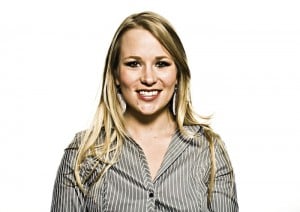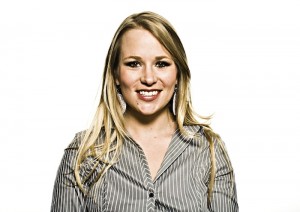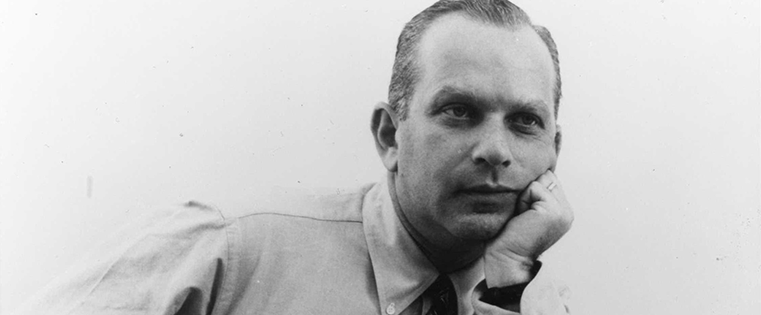 Welcome to The Agency Post! Tell us a little about yourself.
Welcome to The Agency Post! Tell us a little about yourself.
I’m Leslie Bradshaw, the President, Chief Operating Officer and Co-founder of JESS3.

I've lived in Washington, DC, for the last seven years, but I will be moving to Los Angeles in June to help expand our team and offices there. As for whence I've come: In 1982, I was born in Carson City, Nevada, and lived in Tahoe Vista (Lake Tahoe) until I was 12. It was at this point that my family moved to Junction City, Oregon, where we started a farm and pinot noir vineyard. As a sixth generation Oregon Trail pioneer, farming and hard work are in our blood. I briefly attended UC Davis in California and then went on to attend (and graduate from) the University of Chicago. Coming full circle: I moved to DC in 2005 about nine months after graduating.
Tell us more about JESS3 and the type of work you do.
We are a company that focuses on information design in the most holistic sense. What I mean by that is that we apply a design-centric lens to everything from complex topics and data sets, to standard communications and marketing objectives, to business intelligence and reporting. To do this we explore a range of strategies and styles before we lock on to what we believe to be the right approach to the strategy, narrative, visual style and delivery medium. This has meant using a wide variety of image-making tools and techniques: puppets, papercraft, infographics, comic books, videos, large scale installations, Facebook applications, open source technologies, mixed media video and slide decks (to name just a few).
What differentiates it from other agencies in the interactive space?
When comparing JESS3 to other agencies, I've observed three main differentiators:
DATA VISUALIZATION — A dedication to the craft of information design and visual storytelling. We have elevated processes and expert talent that aren't diminished by having to develop overly-branded marketing content or worn-out by things like 60,000 page website redesign projects.
"MILLENIALISM" — A digital nativeness that most agencies are, only in recent years, trying to retrofit into their practices and offerings. We've always been deeply entrenched in online communities, adopting the latest platforms first and leveraging cloud-based services to collaborate and manage our agency. These are our roots from which the rest of the company has grown. As millennials, my partner Jesse and I are the first of the next generation of agency owners. It is an exciting and fascinating moment for the industry.
CONTENT AS A SERVICE — We are committed to the idea that content should be a service and not a delivery mechanism for a highly branded marketing effort. We look at producing exceptional content — meaning it has integrity, beauty and utility that, together, drives conversation and engagement — as an act in balancing the marketing objectives and brand guidelines of a client with the goals of the end user. The end user wants at least one of the following: to be entertained, to be informed or to be seen as smart among his or her peers. Marketing objectives and brand guidelines can often times interrupt and overshadow these goals. That's where we roll up our sleeves and get to work, educating our clients about how the end user and "winning the hearts and minds of the Internet" will ultimately advance their goals of impacting the conversation. Not everyone gets this, but the ones that do are true believers. Just ask our clients at Google, Nike, Eloqua, American Express, Mindjet and Intel.
As the President and COO of JESS3, you’ve helped to grow a startup into a respected and well-known leader in data visualizations. What strategies and company goals helped your team to accomplish this?
I appreciate the recognition, as it has been six long and hard years to get to this point. My strategic approach has evolved over the years, but there have been three common themes that I think are important to call out (they are also the three pillars of JESS3's core values):
Teamwork: I could write an entire book (series even) on the importance of teamwork in a startup. When you first start out, you are asking more of your team than is humanly possible. You are asking them to stretch across multiple roles and responsibilities. You are asking them to work extreme hours in order to achieve project goals, while also trying to achieve operational stability and hit growth goals. The ability to collaborate, demonstrate mutual respect, survive and thrive in these conditions is what being a team is all about.
All the while, you need to compete with the "big guys" and win more and larger business deals. I liken it to "doing the Ginger Rogers" — doing everything Fred Astaire (read: Madison Avenue) is doing, only backwards and in heels. To mix metaphors, I also see the team as soldiers fighting in a series of battles that are a part of a larger war. I've had the honor and privilege of battling in the trenches with some of the most tenacious and talented "soldiers" — some are still with us after years of battling, like our founder and CEO Jesse Thomas, VP of Production and Operations Becca Colbaugh, our Comptroller Carol Zirkle, Director of Motion Mark Kulakoff and our Senior Designer Eric Leach. Other soldiers have since moved on, but I salute every single one of them because they helped bring us to this point. I am an incredibly fierce advocate for my team, they are everything to me.
Attitude: I've employed equal parts positivity, optimism, compassion and ferocity to get to this point. Things rarely go as you hope they will and having the ability to adapt, realign, keep going *and* produce results is where winners are made (and how successful companies like JESS3 are built). My tenacity and positivity have allowed me to keep going when most would have given up.
Craft: The dedication to the craft is what guides our agency. It is our north star. Whether you are an analyst, account manager, engineer, image maker, project manager, strategist or information architect, we all share a passion for advancing our skills and expressing our craft in the highest, most innovative ways possible. My personal "craft focuses" have been: leadership, strategy, operations and client relations.
Recently, JESS3 has decided to re-focus its business model back to its original core capabilities? What caused JESS3 to expand its offerings to other services?
We are always looking for ways to earn a bigger seat at the table with our clients. When we offer — and deliver on — more service offerings, budgets increase and our ability to drive strategy further upstream does as well.
While information design and visual storytelling will always be at our core, we will never stop experimenting with new service offerings that react to the needs of our clients, take advantage of the trends we observe and create stretch opportunities that allow us to innovate and disrupt.
How has focusing your agency as a specialist in a certain discipline helped your overall business model?
By specializing in data visualization, we've created our own lane within an otherwise congested freeway of creative agencies. Being the best in class at information design and visual storytelling has meant we've caught the eye of some of the biggest brands in the world — Google, Nike, Intel, American Express, to name a few — and enabled us to have an unique, trusted relationship with them. Said another way: Our comparative advantage drives business opportunities that come with less competition and more trust, which in turn allow us to focus on the work versus the winning of the work and educating and convincing around the approaches we take.
I highly recommend Matt Creamer's article in AdAge in late April for a much deeper look at this question — both for my answer and additional insights from folks at Osborn Barr, Ignition Consulting Group, Sq1 and LatinWorks.
You describe yourself as a process engineer and a social scientist? What does this say about you and the way you approach your work?
It says that I am good at streamlining varying disciplines, concepts and individuals in efficient and effective ways, while also paying close attention to group dynamics, what motivates contributors and detractors and how to align everyone in order to achieve an end result.
I approach my work — whether for a client or for the entire company — with a keen sense of what the end goal is, what the system dynamics I am dealing with are (e.g., personalities, experience levels, resources, externalities) and what the most resource-effective ways are to get the job done. I also look for all contributors to genuinely feel like they are part of the process and that they share pride in the outcome.
You were named The Most Influential Woman in Technology in 2011 by Fast Company, and you have received recognition as one of the top female entrepreneurs. How did you find your passion in technology and entrepreneurship?
My passion for technology has its origins in my passion for math and science, which, as fields of study, provide the logic, laws, systems and elements that make technology possible. Growing up, my parents and teachers constantly encouraged me and facilitated everything from advanced coursework, to GATE/ TAG programs, to specialized camps and competitions. Through these activities and courses, I was introduced to the fundamentals of technology: the scientific method, advanced mathematics and computer science.
As for being an entrepreneur, I would say it is part genetic and part learned. My parents are both entrepreneurs, purchasing property in Oregon in the late ‘80s and founding a vineyard in the early ‘90s. We will be celebrating our 15th harvest this fall. Prior to founding the vineyard, I watched my dad rise in the ranks from a lift operator to the general manager of a prominent ski resort in Lake Tahoe, while my mom had her own set of clients as an accountant. My mom also comes from a long line of pioneers and farmers, as her ancestors homesteaded in Idaho and Oregon after journeying cross-country on the Oregon Trail (the actual trail, not the computer game). I learned early on — and had regular reminders — that long days of hard work in pursuit of your own dreams, can be incredibly rewarding.
There is obviously a great disparity in the number of female in leadership roles in the tech industry. What advice would you give to young female entrepreneurs, computer engineers and technologists?
Four pieces of advice: learn how to negotiate, always exude confidence, know your stuff and, in the words of Sheryl Sandberg, keep your foot on the gas pedal.
JESS3 has worked on some amazing projects, from partnering with Google on the 2012 primaries to working with Nike and Facebook. What have been some of your favorite projects to work on or your proudest achievements?
The projects that I am most proud of tend to touch on four common themes: (1) delivering real meaning for the end user, (2) teamwork, (3) a high level of experimentation and innovation and (4) the process — the learning, excitement, failure and success — in all of its raw glory.
A few projects that qualify in all of these areas for me include: The 2008 C-SPAN Convention and Debate Hubs, the C-SPAN Video Library, I Voted, The Economist "Women's Economic Index", The Content Grid, Intel iQ, The Zen of Steve Jobs, design and strategy for Google Politics & Elections this cycle (as you've mentioned), the Social Media ProBook, The State of Wikipedia, Amnesty International's 50th anniversary infographics and ESPN TV Ratings 101.
JESS3’s data visualizations have been published on Fast Company, Mashable, Brain Pickings, Good Magazine and other major publications. What do you think the value of infographics is to publications? Why do you think your infographics in particular are so well-received by publishers and readers alike?
Infographics are just one of many ways to tell a data-driven story, so I tend to reject the idea that they are the alpha and omega of data visualization. We've experimented with video and interactive media to tell meaningful stories with data and complex topics, alike. I think the bigger trend here is visual storytelling and finding effective ways to tell stories through a combination of high-impact visuals, high-integrity information and, in some cases, movement and interactivity. As humans, we've been telling stories through things like cave drawings and hieroglyphics for centuries. Infographics, videos and interactive visualizations are merely our modern vehicles for story delivery.
What types of clients/projects are attracted to a creative firm with a data visualization niche expertise?
We've watched it run the gambit from internal communications teams to business intelligence teams to consumer marketing teams. Some groups are looking for more effective ways to communicate to stakeholders (read: non-PowerPoint, non-Excel, non-boring), while other groups are looking for ways to better process and visualize analytics and mission critical information. Others are looking for ways to take the "social exhaust" we all give off across the web and visualize it back to us in compelling and valuable ways (we've seen demand surge around large events like breaking news, sporting events, natural disasters, movie launches, awards shows).
What makes an infographic “good”? How do you create work that stands out from the multitude of infographics published each month?
My broad opinion on this question is that a good infographic needs to follow a proper process: strategy, research, analysis, copywriting, wireframing, graphic design/illustration and quality assurance. I would wager that a small percentage of the infographics that are pumped out each month in fact follow this process. My more applied opinion is that infographics that tell a definitive story through beautiful visuals and high-integrity information have a fighting chance in the sea of otherwise mediocre infographics.
What exciting trends do you see in the field in data visualizations and interactive agencies?
As recently discussed in AdAge, the idea that data will play an increasingly larger role in informing the efficacy of marketing and advertising efforts is exciting to me. I've always been a huge advocate of getting ones' hands dirty in the data and using the insights to make decisions about future initiatives. This will only become more important and normalized in the years to come.
I am also interested to see where folks like R/GA and Google's Creative Labs group take their entrees into data visualization. Announced just over a year ago, R/GA opened a data visualization group and Google's Creative Labs group has a specific division called the Data Arts Labs. Both companies have been hugely influential in the agency and technology space and have a lot of potential to drive the trend of data visualization beyond the infographic and into other media for the creative agency industry. Another company that continues to be an inspiration and a trendsetter is Stamen. Although their reach isn't at the R/GA and Google level, their work and thinking are in a class of their own.
What are your plans for the future of JESS3?
Our short-term plans are to move to Los Angeles and grow out our already stellar team, led by our Director Mark Kulakoff and Executive Producer Tracey Carl. We're hiring for a number of key roles, including interactive and content creative directors, interactive designers, front-end engineers and strategists.
Our near-term plans are to continue to hone our processes and practices so that our team can do their best work.
Our long-term plans are to continue to innovate and pioneer within the data visualization space, which will include more interesting partnerships like those we have with all of the major social networks and exploring the productization of our presentation and interactive offerings.
One reason that you love what you do: How wildly talented, collaborative and tenacious my team is. It is a joy, honor and adventure to come to work every day.
Mentors: Karen Vander Linde, Dave Gryce, Esther Alpert, my mom and my dad.
Must read book: Sylvia Plath's “The Bell Jar”
Music that gets you in your zone: The soundtrack from “Drive”
Connect with Leslie on Twitter @lesliebradshaw or on LinkedIn. Follow her Forbes’ column More (Power) Seats or find out more about data visualizations on JESS3’s Slideshare.
Feature image courtesy of Flickr user joshuaseye.

![21 Quotes on Advertising From Howard Luck Gossage [Infographic]](https://blog.hubspot.com/hubfs/%5BAgency_Post%5D/Blog_Images/gossage-quotes.jpg)


![Judy Wellfare of Plus on Dynamic Storytelling and Culture as Currency [POV]](https://blog.hubspot.com/hs-fs/hub/53/file-1890516411-jpg/blog-files/judy-welfare-plus-199x300.jpg)
![Jamie King of Camp + King on Brand Control and the Art of Advertising [POV]](https://blog.hubspot.com/hs-fs/hub/53/file-1525579750-jpg/blog-files/jamie-king-291x300.jpg)
![Buzz Radar Creates Social Command Centers for Brands [Tech Profile]](https://blog.hubspot.com/hs-fs/hub/53/file-1520157779-jpg/blog-files/buzz-radar.jpg)
![Sean Lyons of Havas on Risk-Taking and Designing an Agency for Collaboration [POV]](https://blog.hubspot.com/hs-fs/hub/53/file-1520156274-jpg/blog-files/sean-lyons-237x300.jpg)
![John Pohlman of Lawrence & Schiller on Building Category Experience and Changing Its Agency Structure [POV]](https://blog.hubspot.com/hs-fs/hub/53/file-1524891732-jpg/blog-files/john_1-1-e1405443798105-300x280.jpg)
![Nico Coetzee of KPI Boutique on Performance Marketing and Agency Waste [POV]](https://blog.hubspot.com/hs-fs/hub/53/file-1524891282-jpg/blog-files/32e8bb2-300x300.jpg)